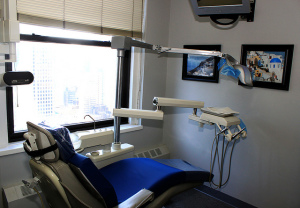Cold and flu season is about to end, but illnesses like strep throat, gastrointestinal viruses and other mild and serious conditions can affect anyone at any time of year. When you visit your dentist, the last thing you want to worry about is getting sick or being exposed to someone else’s germs.
In any healthcare practice, certain infection control measures are taken. Here’s what dental offices do in order to keep patients healthy and safe from contracting communicable illnesses.
Universal Precaution
First, you’ll notice that your dentist, hygienist and assistant wear personal protective equipment when treating you, or anyone else. This includes gloves, masks and/or eye protection, depending on the procedure. This type of equipment helps keep the staff safe from all types of communicable diseases, from mild infections like the common cold, to more serious diseases such as hepatitis. If the staff stays healthy, they’re not able to pass any airborne illnesses to you if they cough or sneeze while you’re in the room, so this type of precaution benefits everyone.
Because it’s impossible to know whether a patient has any type of communicable disease, these precautions are used for every patient, regardless of their medical history.
Barrier Protection
Other types of barriers are used for the patients’ protection. For example, you’ll probably find that the dental chair’s headrest is covered in plastic. You might also see covers on the light handles and on various other surfaces in the room.
These barriers help keep saliva and other fluids from touching surfaces, which makes it impossible for them to infect the next patient in the room.
Spray, Wipe, Spray
After a patient leaves the operatory, all of the surfaces in the room are cleaned. Some equipment is wiped with antimicrobial wipes. Other surfaces are sprayed with an antimicrobial spray. The general rule of thumb for killing germs is to wet the surface, allow it to dry, then wet it again. In the case of sprays, this is usually done by spraying, wiping down the surfaces, then lightly spraying again. Sometimes, the room will be sprayed and allowed to dry, then sprayed again and wiped.
Instrument Sterilization
Of course, the instruments that go into your mouth are not just wiped off; they’re cleaned carefully in the sterilization area of the dental office. Depending on the type of instrument, they might be put through an ultrasonic cleaning machine, soaked in a cold-sterilization solution, put in an autoclave, or run through a special dry-heat sterilization unit.
Procedures vary depending on the type of equipment that a dental office has. If you have questions about how a particular item is sterilized between uses, ask one of the staff members how it’s done!
Because dentists and hygienists are working in your mouth, it’s important that you feel confident that all appropriate steps are taken to keep you safe from other people’s various viruses and germs. Don’t hesitate to ask about how your dental office is handling infection control.













